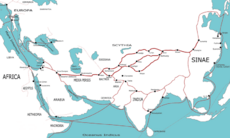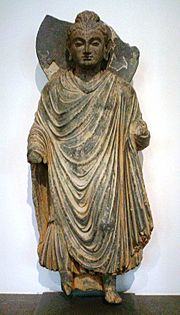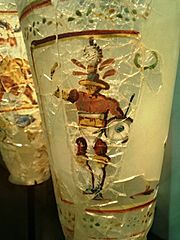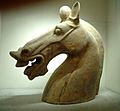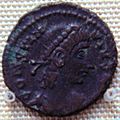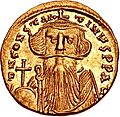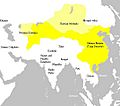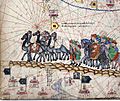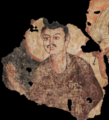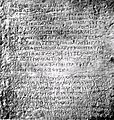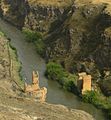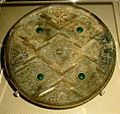Silk Road facts for kids
Quick facts for kids Silk Road |
|
|---|---|
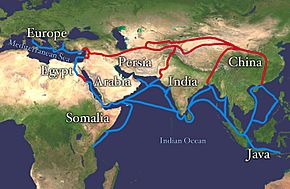
Main routes of the Silk Road
|
|
| Route information | |
| Time period | Around 114 BCE – 1450s CE |
| Official name: Silk Roads: the Routes Network of Chang'an-Tianshan | |
| Type: | Cultural |
| Criteria: | ii, iii, iv, vi |
| Designated: | 2014 (38th session) |
| Reference #: | 1442 |
| Region: | Asia-Pacific |
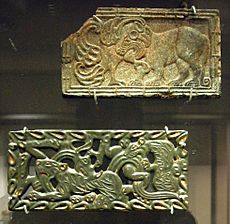
The Silk Road was a network of old trade routes. These routes stretched across Asia all the way to the Mediterranean Sea. This allowed China to trade with the Middle East and the lands around the Mediterranean.
It was called the Silk Road because silk was a very important item traded along it. Back then, silk was only made in China. It was a rare and valuable material. The Silk Road helped China earn a lot of money. Many cities along the route also grew rich and busy because of this trade. Cities like Samarkand and Bukhara became big thanks to the Silk Road.
Trade on the Silk Road helped many ancient cultures grow. These included China, Egypt, Mesopotamia, Persia, India, and Rome. It played a big part in shaping the world we live in today. The name "Silk Road" comes from the German word "Seidenstraße." A German geographer first used this name in 1877.
Contents
What Was Traded on the Silk Road?
Of course, many other things were traded besides silk. Even ideas traveled along these routes! Traders came from many different places. They brought new ideas to China, and China's ideas were carried to other lands.
Some other goods traded included porcelain and other types of pottery. Food, wine, and spices were also popular. Chess pieces from northern India reached China and Persia. Paper also traveled west from China. Metals and jewels were definitely moved along the road. It is also likely that slaves were traded.
It's important to know that most traders did not travel the entire length of the Silk Road. Goods would be traded from one person to another at different stopping points. Deals were often needed to get past difficult areas or groups.
The Silk Road's Path
The main land route of the Silk Road started in northern China and headed west. This land route then split into two main branches. One branch went north of the Tibetan Plateau. The other branch went south of it.
After these two parts rejoined, the route went almost straight west. It passed through mountains and cities like Tabriz in northern Iran. It then went past the northern edge of the Syrian Desert to the Levant (which includes Syria, Israel, and Palestine). From there, trading ships in the Mediterranean Sea took goods to Italy. Other land routes went north through Anatolia or south to North Africa.
There was also a "Silk Road" by sea. This sea route started in South China. It went through the Philippines, Brunei, Siam, Malacca, Ceylon, India, Pakistan, and Iran. In Europe, it connected places like Israel, Lebanon, Egypt, and Italy. Beyond the Mediterranean Sea, it continued to Portugal and Sweden.
How the Silk Road Changed Cultures
The Buddhist religion and a mix of Greek and Buddhist cultures began to spread east along the Silk Road. They reached China around the second century BC. Trading also helped spread many arts and crafts. Different religions and new foods came to China because of the Silk Road. Chinese people helped build and use the Silk Road. They bought and sold with others, which helped their own culture grow.
The Kushan empire, located in the northwest part of India, was a central hub for these trades.
The Silk Road brought other cultures into Central Asia and China. It also helped the rise of the Mongol Empire, which became the largest land empire in history.
The Roman Empire, which bought many Chinese goods, started to lose power in the West around the 5th century. In Central Asia, Islam began to spread in the 7th century. This stopped Chinese expansion westward after a big battle in 751 AD. More growth of Islamic Turkish groups in Central Asia from the 10th century further slowed down trade in that part of the world.
Images for kids
-
Woven silk from a tomb in China, dated to the Western Han Era, 2nd century BCE.
-
The Persian Empire at its largest, showing the Royal Road.
-
A soldier with a centaur from the Sampul tapestry, 3rd–2nd century BCE, China.
-
A ceramic horse head from the Chinese Eastern Han dynasty (1st–2nd century CE).
-
A bronze coin of Constantius II (337–361), found in Karghalik, Xinjiang, China.
-
A Westerner riding a camel, Northern Wei dynasty (386–534).
-
A coin of Constans II (641–648), a Byzantine emperor who sent envoys to China.
-
A Chinese sancai statue of a Sogdian man with a wineskin, Tang dynasty (618–907).
-
Empires and city-states of the Horn of Africa, like the Axumites, were important trading partners.
-
Marco Polo's caravan on the Silk Road, from 1380.
-
The Round city of Baghdad (767–912) was a very important city on the Silk Road.
-
A Yuan Dynasty Celadon vase from Mogadishu.
-
Port cities on the maritime silk route visited during the voyages of Zheng He.
-
Yangshan Port of Shanghai, China.
-
Port of Trieste.
-
The Nestorian Stele, made in 781, tells about Christianity coming to China.
-
A piece of a wall painting showing Buddha from a stupa in Miran along the Silk Road (200-400 AD).
-
A statue of Buddha giving a sermon, from Sarnath, 8th century.
-
Sultanhani caravanserai.
-
Shaki Caravanserai, Shaki, Azerbaijan.
-
Two-Storeyed Caravanserai, Baku, Azerbaijan.
-
A bridge in Ani, the capital of medieval Armenia.
-
Medieval fortress of Amul, Turkmenabat, Turkmenistan.
-
A Sogdian man on a Bactrian camel, Chinese Tang dynasty (618–907).
-
A late Zhou or early Han Chinese bronze mirror with glass inlay.
-
A Chinese Western Han dynasty (202 BCE – 9 CE) bronze rhinoceros with gold and silver inlay.
-
Han dynasty Granary west of Dunhuang on the Silk Road.
-
A green Roman glass cup found in an Eastern Han dynasty (25–220 CE) tomb, China.
See also
 In Spanish: Ruta de la Seda para niños
In Spanish: Ruta de la Seda para niños


